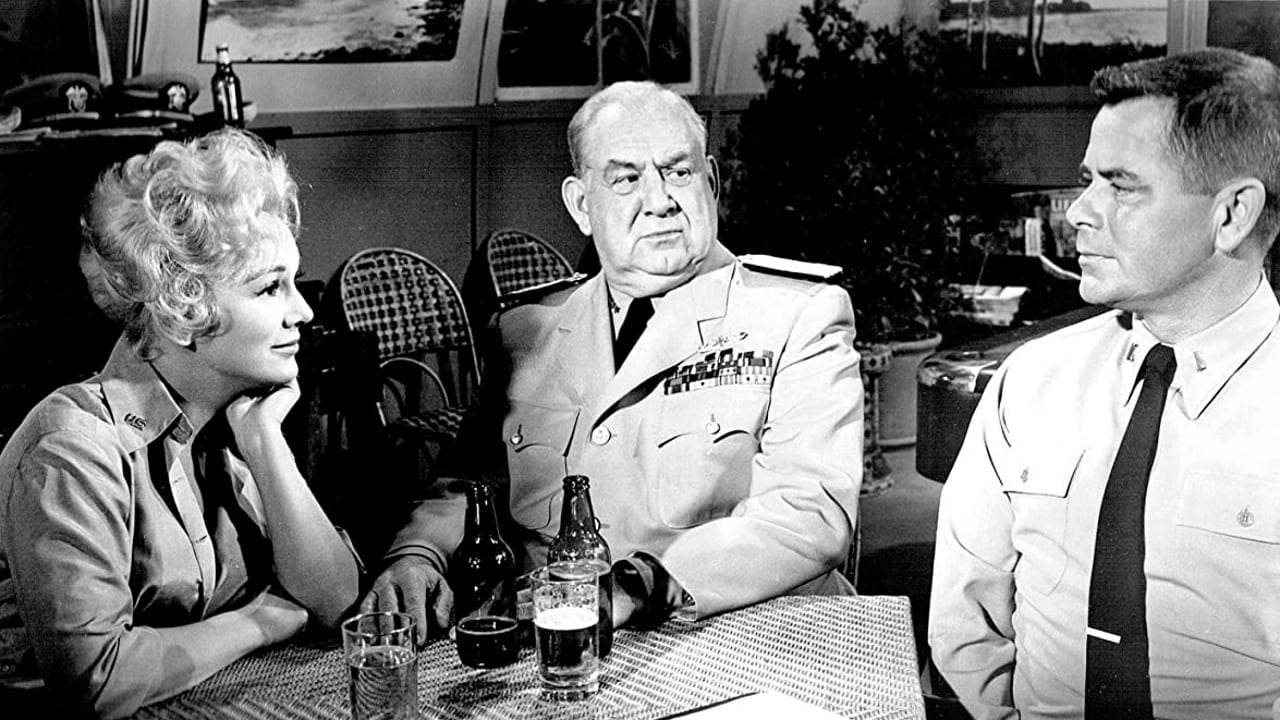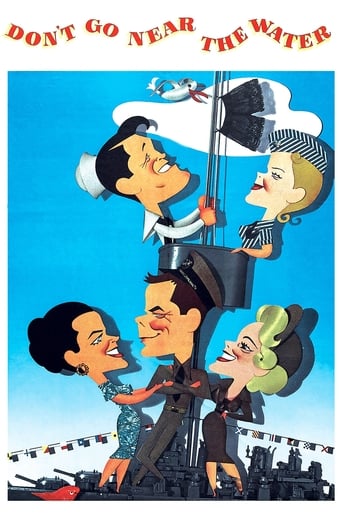

Very very predictable, including the post credit scene !!!
... View MoreThis is a must-see and one of the best documentaries - and films - of this year.
... View MoreI enjoyed watching this film and would recommend other to give it a try , (as I am) but this movie, although enjoyable to watch due to the better than average acting fails to add anything new to its storyline that is all too familiar to these types of movies.
... View MoreThe movie turns out to be a little better than the average. Starting from a romantic formula often seen in the cinema, it ends in the most predictable (and somewhat bland) way.
... View MoreOn a picturesque South Pacific island, during World War II, a US Navy base handles public relations. Unmarried star lieutenant Glenn Ford (as Max Siegel) takes visiting congressmen on a tour. Beautiful native schoolteacher Gia Scala (as Melora Alba) catches his eye. Enlisted sailor Earl Holliman (as Adam Garrett) likes the way pretty perfumed Anne Francis (as Alice Tomlen) "crosses her legs." Laidback young Russ Tamblyn (as Tyson) doesn't like washing teen-spirited sheets for war reporter Keenan Wynn (as Gordon Ripwell). Comic commander Fred Clark (as Clinton "Marblehead" Nash) is in charge. If you stick around, you'll see head-turning Eva Gabor (as Deborah "Debbie" Aldrich and foul-mouthed Mickey Shaughnessy (as Farragut Jones)...The all-star cast is likable. However, the juvenile romances, snickering innuendo and silly slapstick don't mix well. Best part is a very funny episode involving Mr. Shaughnessy reputedly using what is politely called "The F-word," but you have to wade through much tediousness to get there. The title "Don't Go Near the Water" refers to the fact that the characters play on dry land – well, until we see Ms. Gabor's lacy black underwear. This was based on a novel, which suggests there might have been a more interesting story somewhere. Although Glenn Ford was then too big a movie star to do it, this would have made a fine half-hour situation comedy starring Mr. Ford, Mr. Clark and Mr. Tamblyn, who provide a solid anchor and cover their demographics.***** Don't Go Near the Water (11/14/57) Charles Walters ~ Glenn Ford, Fred Clark, Russ Tamblyn, Earl Holliman
... View MoreDon't Go Near The Water is a film about those under-appreciated men of the second World War, those who served way in the rear echelon in the Navy's publicity department. They too, sacrificed and served their country in most unusual ways.Hero of this piece and perfectly cast because of his gift for dead pan comedy timing is Glenn Ford, playing a Mister Roberts like officer assigned to the unit headed by Fred Clark. Actually Ford's a Roberts in reverse, he's already had his sea duty and now is assigned to this backwater of the war. He and Russ Tamblyn would like to get into action because it is in combat that promotions can be quickly earned. Not to mention they'd like to serve their country.Now Clark's perfectly content where he is. He was a former advertising man in civilian life, so the Navy publicity unit is a perfect fit for him. He's even got far more leverage in 'disciplining' the men under his command. But he can be played and Ford does so like a piccolo.Don't Go Near The Water has no real plot except for Ford's yeoman Earl Holliman falling for one of the Navy nurses, Anne Francis, and stealing her away from wolfish officer Jeff Richards. That's a romance that Ford's helping in every way he can despite those no fraternization policies between enlisted men and officers.The film is a series of comic vignettes as the unit tries to deal with several non-military and military situations like a hero sailor played by Mickey Shaughnessy who can't control his language. I found that extremely true to life because back in those brief days when I was a weekend warrior, I remember those Anglo-Saxon expletives coming out just as frequently as they do from Shaughnessy. Still it won't do to have him on a bond tour with that coming out of him all the time, so Ford has the unenviable duty of cleaning his act up.Ford's also taking time to romance island school teacher Gia Scala and he enlists her help in blackmailing an obnoxious war correspondent to help with building a new school house with the money he flashes around from his publisher. The correspondent is Keenan Wynn who thinks that Ensign Russ Tamblyn is his personal valet. No wonder Tamblyn wants to get to active duty.And then there's the glamorous Eva Gabor who is a female correspondent who's been assigned to a forward area to cover the impending battle for Okinawa. As if Admiral Howard Smith hasn't enough troubles. He already has a low opinion of Clark and his outfit as a bunch of goldbrickers.All in all it's a pretty funny service comedy and holds up well after over 50 years.
... View MoreI rate William Brinkley's beautiful written and only slightly pretentious service comedy "Don't Go Near the Water" as the best satire to come out of WWII. There is nothing lightweight about his attempt here; he is writing from personal knowledge of this group of reporters about the hysteria, professionalism, patriotism, irresponsibility, hijinks and occasional hubris of the press who covered the War in the Pacific Theater-of-Operations. The head of the organization is a refugee from Wall Street, chrome-domed comedy genius Fred Clark, riding herd on a large group of bright, bored and nefarious group of minds who are looking to avoid duty or to do something that will shake up the world. Only two changes were made from the novel by Dorothy Kingsley's brilliant screenplay. One was to alter Max, the central character, from a big unattractive sort to handsome Glenn Ford; the other was to change the character played by Earl Holliman from a big handsome hunk to an ordinary- looking nice guy. One works; the other doesn't. But everything else, in my judgment, works like clockwork in this extremely memorable, funny and thought- filled narrative. Director Charles Walters kept the proceedings going professionally and well. The technical aspects of the movie are both good and usually so good they go unnoticed, because what matters in this story, I claim, is the characters and the actors who bring them to vibrant life. The storyline involved is simple. The correspondents get a Club built; Max handles one Farragut Jones, a foul-mouthed nightmare he helps create, by riding herd on him during personal appearances. He also baits Clark, his boos, and pursues a lovely island girl, played by Gia Scala, while facing five disruptions--an illicit liaison between an enlisted man and an officer, an obnoxious demanding journalist, a lovely female reporter who wants to see the shooting war up close, some visiting VIPs and Clark's interference in the challenge of building the Club which all upsets the dull daily routine of the newshawks. The large able cast is headed by Ford, Clark, Holliman, Anne Francis, A\Mary Wickes, Keenan Wynnn as the journalist, Eva Gabor as the female reporter, Mickey Shaughnessy as Farragut Jones, with Romney Brent as Scala's father, Jack Albertson and Charles Watts as the Representatives, Jeff Richards and Howard Smith. Bronislau Kaper supplied the music; the film produced a hit song. And when the atomic bomb is dropped on Japan, the film achieve a climax at a large bash, and a happy ending for Ford and Scala. The most hilarious and meaningful service comedy of which I have knowledge. its theme is really how men deal with responsibility, and everyone is memorable because the theme is so well- integrated with the War and its events. Kudos to William Brinkley for this absolute gem.
... View MoreThis tale of the absurdist goings-on at a public relations office for the navy in the WWII pacific theater is sort of a downscale "South Pacific." The casting and production values are extremely high, but the movie never aspires to anything more than light (extremely light) entertainment. In this it succeeds quite well. The movie is great to look at, and the comic abilities of Glenn Ford - an underrated actor, in my book - are at their peak. No lasting nourishment here, but a fun flick to see - once. Side note - the movie is another example of the superiority of the color processes employed in the 50's and late 40's over what is commonly used in today's flicks.
... View More